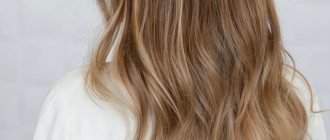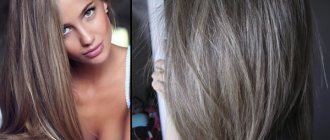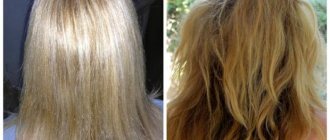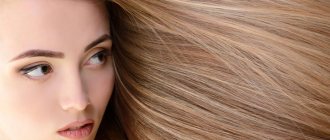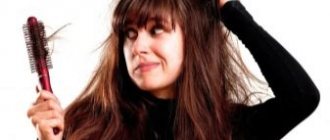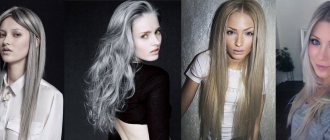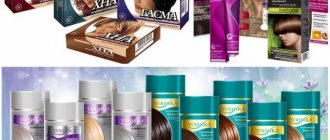What are the advantages of ammonia-free hair dye?
The Schwarzkopf company was the first to produce ammonia-free hair dye. Such dyes existed before, but they were all unstable. It was necessary to improve the formula. The first permanent and hair-friendly dye without ammonia was released with the participation of the Schwarzkopf company.
The advantages of ammonia-free paint, according to manufacturers, are as follows:
- nice smell;
- complete coverage of gray hair and making hair silky and soft;
- maintaining the health and structure of hair, preventing it from drying out;
- ammonia-free paint is suitable even for pregnant women, since its harm due to the absence of ammonia is reduced to zero.
Ammonia-free paints provide a lasting result, while the coloring will be gentle. You need to dye your hair less often. Manufacturers claim that such ammonia-free dyes help protect hair from the negative effects of dyes, helping it remain natural, elastic, and healthy.
Professional coloring or do-it-yourself image change: 2 ways to black curls
The level of development of the cosmetic industry allows women to easily change the color, length and even structure of their hair. Changing your look is now a matter of a couple of hours: you just have to go to the store and buy paint of the desired shade.
Changing your look with hair color is not a problem, since today there is a huge palette of hair colors
The issue of changing the image becomes more relevant with the change of season, when the nature around shows its renewal, and you want to follow its example.
The popularity of hair colors with shades of red, brown, ash, blue, cherry and currant purple
Although today in stores you can find a rich color palette of dyes, natural shades and unimaginable fluorescent dyes, the classic black color has not lost its popularity since the time when the first black hair dye was invented.
Black color is both natural and bright. It highlights the face favorably and makes makeup visually brighter. Black color perfectly reflects the sun's rays: no shade of blonde shines in the sun as brightly as a brunette's hairstyle.
In addition, these rich colors have historically had a special image attached to them. If red is the color of passion, and blonde is the color of diamond luxury and girlish spontaneity, then brunettes were considered to be intellectuals and femme fatales.
Many book and movie heroines had black curls. The black color indicates that its wearer is an extravagant woman, but at the same time adhering to the classical canons, which are always in demand.
This is not difficult to notice in the fashion world: the black dress remains, despite any innovations that current designers come up with.
Likewise, black hairstyles are always at the peak of fashion: it goes well with both a conservative image and a bright youth image, full of vibrant colors.
Black color is always at the height of fashion among colorists. Sometimes natural black shades, with a tint of natural colors, are at the peak of relevance. Sometimes, on the contrary, it is better to use black hair dye with a purple tint.
What's the best way to dye your hair black?
The first thing that is important to think about when deciding to paint yourself black is whether this color suits you. Black curls favorably emphasize light skin color, with them the face becomes brighter. But they make the slightest redness on the skin more obvious and make them look older.
Health problems are more noticeable on dark strands. With black hair, your face may become completely pale and look sickly.
In addition, black hair dyes are difficult to remove. If you decide to change the color of your hair, you will have to grow the length again.
Dark pigment does not stay well in light hair. To turn a blonde into a sultry brunette, you will need more than one coloring.
To change your image, you can go to a salon, where the hairdresser will select a professional dye based on the structure and condition of your curls.
You can buy paint at the store. Now there are many well-known brands, the use of black hair dye from which will allow even a girl who has never dyed her hair before to easily carry out the procedure at home and achieve a good result.
Paints for home use are created taking into account what ordinary people who do not have the skills of a colorist will use.
You can use natural dye basma. With its help, you can become a brunette without harming your hair, but on the contrary, improving its appearance.
How to use natural basma (henna) correctly: a professional approach
To dye your basma black, just follow simple instructions, which contain several basic points for working with this natural dye:
- First, basma is mixed with henna in a ratio of 2 to 1. Henna is needed to provide the desired shade: pure basma has a greenish color. By adding more henna, you can make the black less saturated, with a reddish tint.
- The mixture is poured with water at a temperature of about 90 degrees, stirring thoroughly until it acquires the consistency of sour cream.
- We wait 20 minutes for the paint to swell.
- Before you start dyeing, put on gloves and clothes that you don’t mind ruining. The skin at the hairline and ears are treated with a rich cream.
- Then the mixture is applied to the entire volume, starting from the roots.
- After thoroughly coating the strands with dye slurry, they are wrapped in polyethylene and a warm hat. You need to sit in this state for an hour to an hour and a half, depending on the intensity you want to achieve.
To ensure that basma-dyed hair retains its bright black color longer, use shampoos and care products made from natural ingredients, and periodically refresh the color by rinsing with a solution of henna and basma.
Black hair dye from world brands: L'Oreal, Garnier black coffee and chocolate, Estelle
For those who do not like dyeing with plant-based dyes, there is a better alternative - black hair dye from famous manufacturers of cosmetics.
Modern black hair dye gives it a rich color, ensuring the durability of the result, making the curls shiny.
As a rule, every popular brand has in its arsenal both permanent dyes and tinting agents and gentle ammonia-free paints.
Tinted products give short-term results: the color, as a rule, is washed off after a week.
Ammonia-free dyes last a little longer, but since they do not contain strong chemical components that can penetrate deep into the hair, the color is quickly washed out.
Painting with permanent paint will give a high-quality result. For several months, your curls will acquire the desired color, which will not wash out or fade. But such paint is harmful, because... has a strong effect on the health of hair.
After using permanent dyes, curls require careful care and sometimes treatment.
The most famous manufacturers of hair dyes are brands such as L'Oreal, Garnier, Syoss.
Londa and Schwarzkopf produce both paints for home use and professional products for salons, which are not sold in regular stores.
All of these companies add various nutrients and components to their dyes that protect hair during the dyeing process.
Rules for dyeing hair blue: black tulip effect
In order for the results to exceed expectations, when dyeing your hair black, you need to remember some nuances:
- If you are not sure that you want to become a brunette for a long time, it is better to use a tint product.
- Carefully read the instructions for the dye and follow them strictly so as not to damage your hair.
- Do not use the wrap if you are dyeing your hair with chemical black dye: this can damage your curls and scalp.
- If you only need to color your roots, apply color to the entire length of your hair only for a few minutes at the end to refresh the color without causing unnecessary damage to your hair.
- Be sure to take care of your hair between colorings using special care products for colored hair.
How to remove the most stubborn black paint on your own
To get rid of black hair, you should start with lightening. It should be remembered that all lightening compounds harm the hair and damage its structure.
To minimize harm, you need to lighten your hair gradually, using high-quality lighteners with a low percentage of oxide. It is better to carry out several procedures, nourishing the hair in between, than to try to achieve results in one go.
After lightening, hair needs special care: masks, decoctions, balms and leave-in products, express restoration courses are your true friends in this matter.
To alleviate the plight of your hair, you can not lighten the entire fabric at once, but do highlighting or coloring, highlighting only some strands. So, gradually in several stages the color of the curls becomes lighter.
WATCH VIDEO INSTRUCTIONS
If your hair is severely damaged and you are worried that you will not be able to properly lighten it at home, then it is better not to risk it and turn to professionals.
How to update black hair color at home
To maintain the intensity of your black hair color, use shampoos and treatments designed specifically for colored hair. They prevent pigment from being washed out of the hair structure and preserve the coloring result for a long time.
Spruce masks help. To do this, spruce bark is brewed with boiling water and the resulting mass is kept on the head for an hour.
There are many masks for restoring hair after dyeing at home.
A mask made from three egg whites, six tablespoons of lemon juice and six tablespoons of apple cider vinegar will make your strands shiny and add freshness to your color.
Walnut leaves will help renew the black shade of your hair: you need to boil 10 walnut leaves in an enamel container along with ten grams of tea leaves, and then wipe your comb with the resulting solution before combing your hair. The solution should be stored in a cool, dark place.
volosyki.ru
Is ammonia-free hair dye harmful?
This question is of great concern to many women, judging by the reviews on the Internet. The thing is that after getting rid of ammonia, manufacturers often replace it with other, no less harmful components. These are, for example, various parabens. Most often it is ethanolamine, and in greater quantities than ammonia. This component, unfortunately, is even more harmful to the skin.
In addition, all paints contain diaminobenzene, methyltoluene, resorcinol and other dangerous chemicals.
Many women, judging by the reviews, choose ammonia-free dyes because they contain nourishing components that care for their hair. It should be remembered that the nutritional effect after using such paints is extremely short-lived.
Professional ammonia-free hair dye
Many women, according to reviews, are concerned about the question of why, when dyeing their hair in a hairdresser, the color lasts more lastingly and goes on more evenly than when dyeing it themselves at home?
The thing is that professional hair dyes have a composition that is very different from the composition of the dyes that we buy in the store. This is a rather complex mixture of various stabilizers and dyes in proportions that can only be selected by a professional master. It is impossible to repeat this at home.
Pevoy channel. Black hair dye causes cancer
A medical study involving half a million women showed that the most dangerous dye is black. Some black dyes can cause cancer.
Human hair is made of 2 parts: one is inside the head, and the other goes outside, that is, the hair itself. The entire human body is covered with hair. For example, there is armpit hair, which, thanks to the sweat and sebaceous glands, allows you to move your arms freely.
There are hairs in the groin area that are designed to allow the legs to move freely because each hair has its own sebaceous gland. Sebum, our body's best cream, is secreted where hair grows, in the hair follicles. In the human body there is a cell containing a dye. Thanks to her, we sunbathe. This is a melanocyte. The cell is connected to the hair by a special channel - the more dye it contains, the darker the hair.
Stylist tips:
First of all, you must love your hair as much as you love yourself. Hair loves care. You need to use high-quality shampoos, hair conditioners, masks. There are many folk recipes that maintain good hair condition.
Water for washing hair should be at a comfortable temperature. Shampoo does not need to be taken in excess. But if you couldn’t rinse your hair well at one time, then rinse with shampoo a second time. You need to wash your hair when it gets dirty.
You need to dry your hair by carefully wrapping your head with a towel and blotting your hair without tugging at it. Gently squeeze hair into a towel. Movements should be soft and blotting.
A wide-tooth comb should be used during conditioning, starting from the ends - this will make the combing process easier.
How to wash your hair properly:
From a medical point of view, wet hair is the most vulnerable. Hair should be washed like fine silk. All movements should be soft.
If your hair is healthy and not greasy, you don't need to wash it every day. This makes no sense. You will only remove the protective layer that nature itself created for your hair, and you will only harm it. Wash your hair when dirty. You don’t need to do this every day, nothing good will happen.
Wet hair is vulnerable Don't wash your hair every day Don't rub, but blot A good comb - with rare teeth Start combing from ends to roots
There are many studies on common things that can somehow affect the occurrence of cancer cells: hair coloring, hormonal therapy, alcohol - all this can lead to the emergence and growth of cancer cells.
It has long been known that for women who have overcome menopause, the risk of breast cancer increases by one and a half times. But only recently have scientists been able to find an obvious link between hormonal contraceptives, hair dye and breast cancer. The study found that those who regularly dyed their hair had a 23% increased risk of cancer. Hormonal contraception increases the chances of developing breast cancer by 32% for those who have used it in the past, and by 52% for women who use this method of pregnancy control regularly. How do all these things affect the occurrence of cancer cells? Let's find out! New evidence suggests that regularly coloring your hair increases your risk of developing breast cancer.
According to the British cancer organization Cancer Research UK, progesterone-based contraceptives increase the likelihood of cancer. By the way, alcohol and obesity also found their place on the list of substances and habits that bring you closer to cancer. Even if a woman’s body simply has a high content of its own hormones, she is still at risk. For example, high levels of estrogen cause DNA mutations, which leads to the formation of cancer cells, and progesterone, in turn, promotes the growth of tumors.
Women using local hormonal contraception (intrauterine hormonal systems) are at the same risk as women taking oral hormones. If we are talking about hormonal contraception, then there is a slight difference between oral contraceptives and local ones, such as intrauterine hormonal systems. Here it is necessary to explain what intrauterine hormonal systems are in general. This is a small plastic device that is inserted directly into the uterus by a gynecologist. The device releases progesterone in the uterine cavity, which helps prevent pregnancy. Among other things, the presence of this system leads to additional tone of the uterus, which makes it much more difficult for sperm to reach the egg. Such systems use a synthetic analogue of progesterone, and, despite the fact that the hormones are applied topically, they still enter the bloodstream. The risk of tumors when using intrauterine hormonal systems is as great as in the case of oral hormonal contraceptives. Even more surprising is the statement of scientists that hair dye contributes to the development of breast cancer. The reason is the substances contained in hair dye. And there really is something to think about. Components such as aniline dyes, ammoniated mercury and hydrogen peroxide can cause allergies. But this is not so bad, because an allergic reaction can also occur to safer components. Para-phenylenediamine is much more dangerous: it penetrates the skin of the hands and head into the body. No less harmful is lawsone, a toxic component that can accumulate in the body and affect the kidneys, circulatory system and stomach. Nonylphenol is another common ingredient in hair dyes. It is also toxic: the substance very quickly settles in fatty tissues, but removing it from the body is much more difficult. Many ladies are probably ready to argue that they get their makeup done in salons, and the paint there is of better quality. Unfortunately, researchers will not be able to agree with this. They claim that these components are so often used that they can be contained both in expensive and high-quality paint, and in cheaper analogues. Experts from the University of Helsinki conducted a survey among 8,000 women suffering from breast cancer. The researchers asked whether these women had ever taken hormonal birth control (either topical or in pill form) and whether they had ever dyed their hair. The survey revealed a direct link between taking hormonal contraceptives (in any form) and breast cancer. The relationship between the disease and hair coloring was also obvious. However, Dr Jasmine Just, communications officer at Cancer Research UK, says the evidence is still insufficient. “All we can say for sure is that a healthy lifestyle, taking care of your health and reducing your alcohol intake will definitely allow you to reduce your risk of breast cancer.”
News from the world of oncology >> Why is there concern that hair dyes can cause cancer? Here's what representatives in the US say about it.
Many people in the United States and Europe use hair dyes. It is believed that more than one third of women over 18 years of age and about 10% of men over 40 years of age use some kind of dye.
Modern hair dyes are classified as permanent (or oxidative), semi-permanent and temporary. Permanent hair dyes, which make up about 80% of all hair dyes sold today, consist of colorless "dye intermediates" (chemicals called aromatic amines) and "spray" dyes.
In the presence of hydrogen peroxide, the intermediates and color formers react with each other to form pigment molecules.
Darker colors are produced when higher concentrations of intermediates are used. Semi-permanent and temporary hair dyes are non-oxidizing and include ready-made formulations that directly color the hair.
There are over 5,000 different chemicals used in hair color products, some of which are reported to be carcinogenic (cancer-causing) in animals. Because many people use hair dyes, scientists have been trying to determine whether exposure to chemicals in hair coloring products is associated with an increased risk of cancer in people.
Early hair dye formulations contained chemicals, including aromatic amines, that have been found to cause cancer in animals. However, in the mid-to-late 1970s, manufacturers changed ingredients in dye products to eliminate some of these chemicals. It is unknown whether some of the chemicals still used in hair dyes can cause cancer. Given the widespread use of hair coloring products, even a small increase in risk can have a significant impact on public health.
Over the years, some epidemiological (population-based) studies have found an increased risk of bladder cancer among hairdressers. A report by the International Agency for Research on Cancer (IARC) concluded that some of the chemicals to which these workers were exposed are “probably carcinogenic to humans.”
While some studies have linked personal use of hair dyes to an increased risk of certain blood and bone marrow cancers, such as non-Hodgkin's lymphoma (NHL) and leukemia, other studies have shown no such links. Studies on breast and bladder cancer have also produced conflicting results. Relatively few studies have been published on the association of hair dye use with the risk of developing other types of cancer. Based on its review of the evidence, the IARC Working Group concluded that personal use of hair dyes "does not lend itself to classification with respect to its carcinogenicity to humans."
Selective Professional
Italian hair dye Selective Professional without ammonia for blondes is also very popular. This lightening mineral dye allows you to achieve a wonderful blonde color without much harm to your hair. Italian manufacturers have other brands of popular paints.
These dyes, of course, can be purchased in an online store and applied to your hair yourself. However, if you are not a specialist and are not sure how to properly mix the components and choose the appropriate shade, then for a guaranteed result it is better to contact a beauty salon.
We hope that our article helped you decide which ammonia-free paint is best and suits your price range. Happy coloring!
